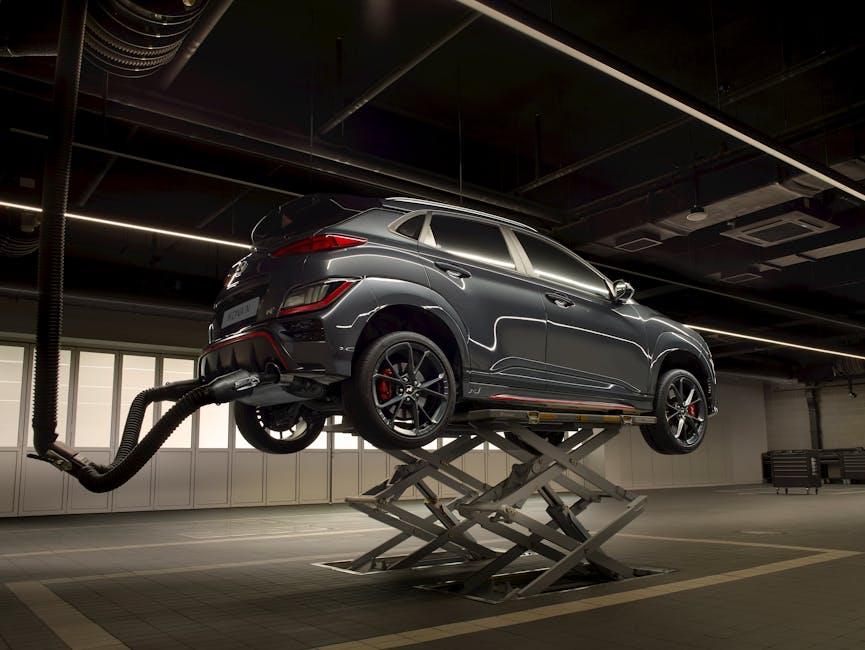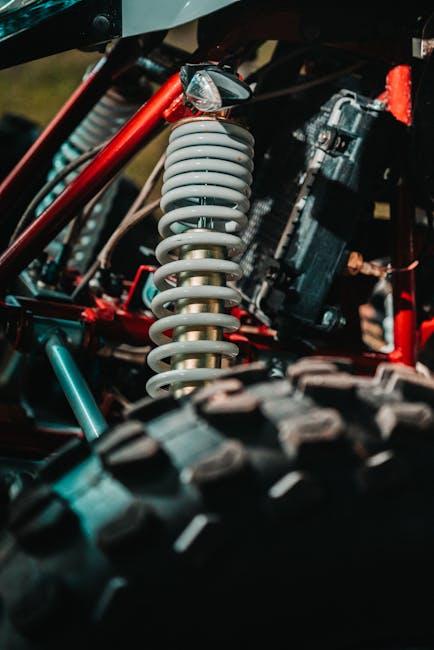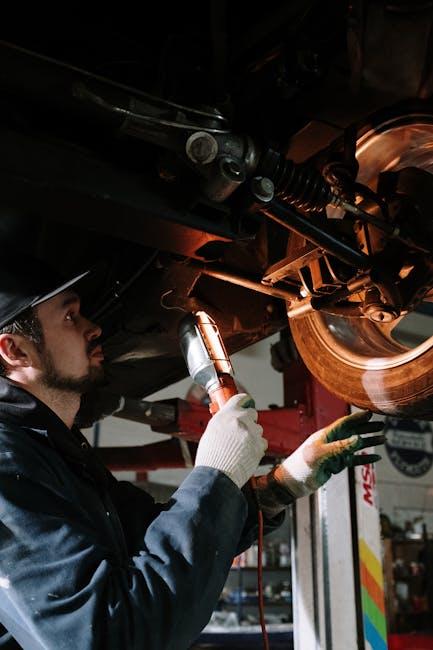The suspension system is the unsung hero of every vehicle, quietly absorbing shocks and smoothing out the bumps on our journeys. Yet, like any mechanical marvel, it is prone to wear and tear, demanding attention and repairs to keep the ride comfortable and safe. Understanding common suspension repairs not only helps drivers recognize warning signs early but also highlights the vital role this system plays in vehicle performance. In this article, we delve into the most frequent suspension issues, exploring their causes, symptoms, and how timely repairs can restore the balance between comfort and control on the road.
Table of Contents
- Understanding the Signs of Suspension Wear and Damage
- Diagnosing Common Suspension Problems with Precision
- Essential Tools and Safety Tips for Suspension Repairs
- Step-by-Step Guide to Replacing Shock Absorbers and Struts
- Choosing Quality Replacement Parts for Long-Lasting Suspension Health
- Preventative Maintenance Practices to Extend Suspension Lifespan
- Q&A
- Final Thoughts

Understanding the Signs of Suspension Wear and Damage
Suspension issues often begin subtly but can quickly escalate if not addressed promptly. Pay close attention to unusual noises such as clunking or squeaking when driving over bumps, which often indicate worn bushings or damaged shocks. Another clear sign is uneven tire wear, which suggests the suspension system isn’t holding the vehicle evenly. If your vehicle pulls to one side or experiences excessive bouncing after hitting a pothole, these physical sensations are red flags signaling component fatigue or failure.
To help you gauge the severity of suspension problems, here’s a quick reference guide:
| Symptom | Possible Cause | Recommended Action |
|---|---|---|
| Vehicle pulling to one side | Worn control arm or misalignment | Schedule wheel alignment service |
| Excessive bouncing | Damaged shock absorbers or struts | Replace shocks/struts promptly |
| Clunking noises | Faulty bushings or loose ball joints | Inspect suspension components |
| Uneven tire wear | Suspension misalignment or worn parts | Rotate tires and check suspension |

Diagnosing Common Suspension Problems with Precision
Pinpointing issues within your vehicle’s suspension requires a blend of keen observation and technical know-how. Start by conducting a thorough visual inspection: check for uneven tire wear, leaking shock absorbers, and visibly damaged or sagging springs. Listen carefully for unusual noises such as clunks or squeaks during turns or when driving over bumps. These signs often indicate worn or broken components needing immediate attention. Furthermore, feeling a persistent vibration or pulling while driving may signal misaligned or failing suspension parts, which if neglected, can compromise both comfort and safety.
For a more structured approach, consider the following checklist to isolate common symptoms and their possible causes:
- Bouncing or inconsistent ride height: Damaged shocks or struts
- Steering wander or pulling: Misaligned suspension or worn ball joints
- Excessive noise over bumps: Broken bushings or loose sway bar links
- Uneven tire wear patterns: Faulty suspension geometry or bad wheel alignment
| Symptom | Likely Suspension Issue | Recommended Diagnostic Step |
|---|---|---|
| Vehicle pulls to one side | Misaligned control arms | Perform alignment and inspect control arm bushings |
| Bumpy ride on smooth road | Worn-out shocks | Check shock absorber leaks and test rebound |
| Clunking noise over bumps | Damaged sway bar links | Inspect sway bar and tighten or replace links |

Essential Tools and Safety Tips for Suspension Repairs
Working on suspension repairs requires precision and the right set of tools to ensure both efficiency and safety. Essential tools include a high-quality floor jack, jack stands, and a torque wrench—each designed to provide stability and accuracy during the repair process. Don’t overlook specialty tools like spring compressors for coil springs or ball joint separators, which make tackling complicated components more manageable. Having a well-organized toolbox not only speeds up the job but also minimizes the risk of equipment failure or injury.
Safety should always be the top priority when performing suspension work. Always secure your vehicle firmly on jack stands—never rely solely on the jack—and wear protective gear such as gloves and safety glasses. When dealing with suspension springs under tension, proceed cautiously; improper handling can lead to serious accidents. It’s also wise to double-check torque specifications using a reliable manual or manufacturer’s guide to avoid over-tightening or loosening critical bolts. Implementing these tactics creates a safer workspace and ensures your suspension repairs stand the test of time.

Step-by-Step Guide to Replacing Shock Absorbers and Struts
Begin by safely lifting the vehicle and removing the wheels to expose the suspension components. Before detaching the old shock absorbers or struts, it’s essential to release any tension in the system by compressing the spring if necessary. Wear safety gear as compressed springs store a lot of energy and can be hazardous. Once tension is relieved, unbolt the mounting hardware carefully, keeping track of all nuts, bolts, and washers. Use penetrating oil to loosen stubborn fasteners. After removal, inspect the mounting points for any signs of damage or rust that may need repair before installing your new parts.
Installing the replacements requires reversing the removal process but with a focus on precision. Start by securing the shock absorbers or struts into place, ensuring they align perfectly with the mounting holes. Tighten bolts to the manufacturer’s specified torque settings for optimal safety and performance. Reassemble the wheels and lower the vehicle carefully. Finally, check your work by performing a simple bounce test to confirm the suspension responds correctly and consider a professional alignment check to maintain proper tire wear and handling.

Choosing Quality Replacement Parts for Long-Lasting Suspension Health
When it comes to prolonging the life of your vehicle’s suspension, investing in high-quality replacement parts is non-negotiable. Opting for components made from durable materials ensures better resistance to wear and tear, reducing the frequency of repairs and improving ride comfort. Look for parts that come with comprehensive warranties and are recommended by trusted manufacturers to maintain optimal performance and safety standards. Remember, the cheapest option may save you money today but could lead to costly problems down the road.
Key factors to consider:
- Material quality: Choose parts built with advanced alloys or reinforced polymers for enhanced strength.
- Compatibility: Ensure the parts are specifically designed for your make and model to avoid fitting issues.
- Performance certifications: Seek out components tested for shock absorption and durability under real-world conditions.
- Professional advice: Consult with experienced mechanics who can recommend reputable brands and suitable upgrades.
| Part | Recommended Material | Average Lifespan |
|---|---|---|
| Shock Absorbers | Steel with Hydraulic Fluid | 50,000 – 100,000 miles |
| Control Arms | Forged Aluminum | 70,000 – 90,000 miles |
| Ball Joints | High-Carbon Steel | 80,000 – 100,000 miles |

Preventative Maintenance Practices to Extend Suspension Lifespan
Regular care is the cornerstone of keeping your vehicle’s suspension in prime condition. By incorporating simple habits such as routine inspections and timely lubrication, you can significantly reduce the wear and tear on suspension components. Pay close attention to any abnormal noises or changes in handling, as these are early signs your suspension needs attention. Additionally, maintaining proper tire pressure not only improves ride comfort but also alleviates unnecessary strain on shocks and struts.
Adopting preventative measures doesn’t have to be complicated. A consistent approach to monitoring and minor repairs can make a big difference:
- Check bushings and joints for cracks or wear
- Rotate tires regularly to ensure even suspension load
- Keep your vehicle aligned to prevent uneven stress on parts
- Address fluid leaks promptly in hydraulic suspension systems
| Preventative Step | Benefit | Frequency |
|---|---|---|
| Suspension Inspection | Identify wear early | Every 6,000 miles |
| Tire Rotation | Even tire wear | Every 5,000–7,000 miles |
| Lubrication of Joints | Reduce friction | Every 12,000 miles |
| Wheel Alignment | Improved handling | Annually or after impact |
Q&A
Q&A: Common Suspension Repairs
Q: What is a vehicle suspension system, and why is it important?
A: The suspension system is a network of springs, shock absorbers, and linkages that connect your vehicle to its wheels. It plays a crucial role in ensuring a smooth ride, maintaining tire contact with the road, and providing overall stability and control.
Q: How can I tell if my suspension needs repair?
A: Common signs include uneven tire wear, excessive bouncing after hitting bumps, a pulling sensation to one side while driving, noises like clunking or squeaking, and a generally rough or unstable ride.
Q: What are the most common suspension components that require repair?
A: The usual suspects include shock absorbers or struts, ball joints, control arms, bushings, and tie rods. These parts wear out over time due to road conditions and driving habits.
Q: How does a worn-out shock absorber affect my drive?
A: When shocks or struts fail, your vehicle might bounce excessively, making steering less responsive and increasing stopping distances. This not only affects comfort but can compromise safety.
Q: What are ball joints, and why do they often need attention?
A: Ball joints are pivot points that connect the control arms to the steering knuckles. Over time, they can loosen or wear out, leading to steering problems and uneven tire wear.
Q: Can I ignore minor suspension noises, or should they be addressed immediately?
A: While some noises might seem minor, they often signal worn suspension parts. Addressing them early can prevent more extensive damage and higher repair costs down the road.
Q: How long does a typical suspension repair take?
A: Repair times vary by the part and vehicle make but generally range from one to several hours. Simple bushing replacements might be quicker, whereas control arm or strut replacements can take longer.
Q: Are suspension repairs expensive?
A: Costs vary widely depending on the damaged component and vehicle type. Basic repairs like replacing bushings are relatively affordable, while strut or control arm replacements are pricier, but essential for safe driving.
Q: Is suspension maintenance necessary if I don’t experience noticeable issues?
A: Yes. Routine inspections can catch wear before it turns into a problem, extending the life of your suspension and ensuring safe, comfortable driving.
Q: Can I perform suspension repairs myself, or should I visit a professional?
A: Some minor fixes might be DIY-friendly for experienced individuals, but suspension work often requires specialized tools and expertise. For safety and reliability, professional repair is usually recommended.
Final Thoughts
In the journey of maintaining a smooth and safe ride, understanding common suspension repairs is like having a reliable roadmap. Whether it’s worn-out shocks, broken springs, or misaligned components, addressing these issues promptly ensures your vehicle continues to glide effortlessly over the road ahead. By staying informed and proactive, you not only extend the life of your suspension system but also preserve the comfort and control that make every drive a pleasure. So, next time your car feels a little off balance, remember: a well-tuned suspension is the quiet hero behind every steady mile.

